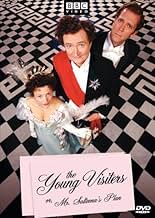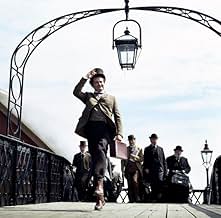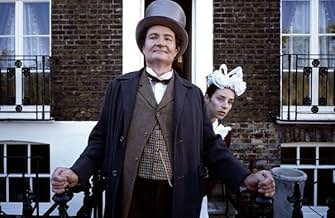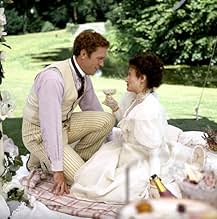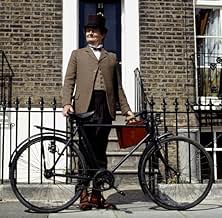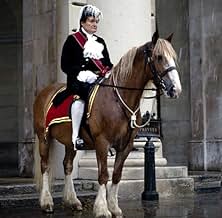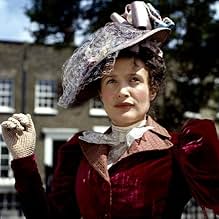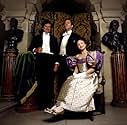Adicionar um enredo no seu idiomaNine-year-old Daisy wrote a novel in 1890 about an awkward gentleman meeting a young lady on a train. He invites her to his London home. She wants to meet high society, so he takes her to a ... Ler tudoNine-year-old Daisy wrote a novel in 1890 about an awkward gentleman meeting a young lady on a train. He invites her to his London home. She wants to meet high society, so he takes her to a lord's country estate.Nine-year-old Daisy wrote a novel in 1890 about an awkward gentleman meeting a young lady on a train. He invites her to his London home. She wants to meet high society, so he takes her to a lord's country estate.
- Direção
- Roteiristas
- Artistas
- Ganhou 1 prêmio BAFTA
- 1 vitória e 3 indicações no total
- Direção
- Roteiristas
- Elenco e equipe completos
- Produção, bilheteria e muito mais no IMDbPro
Avaliações em destaque
The production standards are top-notch, and the acting, particularly the character of Mr. Salteena, is extremely well done.
BBC did a phenomenal job.
"The Young Visitors: Or, Mr. Salteena's Plan" was written by nine-year-old Daisy Ashford in 1890 (yes, 1890!) and is an innocent yet inadvertently amusing spoof of Victorian society.
The following is a copy of the book review written by Terry Rose, grandson of Daisy Ashord, as appears on www.amazon.co.uk:
"My Grandmother, Daisy Ashford never set out to become an author, writing stories was entertainment for her and her sisters. Her writing "career" started at the age of 4 when she dictated The Life of Father McSwiney to her father and ended at the age of 14 with The Hangman's Daughter. Her best novel, The Young Visiters was written in 1890 when she was 9.
That it was published at all is almost as remarkable a story as the book itself. Daisy and her sisters came upon a bundle of notebooks neatly tied and stored whilst clearing their mother's house following her death. They found The Young Visiters so amusing Daisy sent it to a sick friend to cheer her up. She in turn passed it to Frank Swinnerton, a novelist and reader for Chatto and Windus who believed it could be successfully published. What followed would these days be thought of as clever marketing but in fact was quite unintentional back in 1919 when the book was first published. JM Barrie agreed to write the preface and an amazed public, unable to accept that a 9 year old could have possibly written it assumed that Dsiy did not exist and that Barrie was the author. This resulted in huge amounts of publicity on both sides of the Atlantic and The Young Visiters immediately became a bestseller. Daisy, always shy and modest had to take to giving readings in London to dispell the myth that Barrie was the author. The Young Visiters has remained in print (Daisy's other stories have been published over the years but none has been as popular) and become widely loved. Other reviewers here have written better than I could about the charm of the little book. The BBC have just made it into a wonderful film, with Patrick Barlow's screenplay capturing the magic of Daisy's writing. We visited the set whilst they were filming at St Paul's Cathedral, the cast were captivated by the book. I think everyone will be."
Taken from a story written in 1891 by Daisy Ashford when she was a nine year old girl, printed in 1919 and has not been out of print since. I must admit not to have heard of it, but the fact that it has never been out of print shows how good it is. I only know it now from this BBC film and enjoyed the story thoroughly. The writing (from a nine year old!) is great, it shows a great awareness of how important class is in British society and just how subjective and meaningless the whole thing is when it comes down to it. Ethel comes off as quite unpleasant in her desire to climb the social ladder but she is also shown to totally know what she is doing. Again, for a 9 year old to be so aware of the power of a pretty young lady is a frightening thing!
The story is told in a comic style and is humorous without taking away from the story. The main material is quite intelligent and very smart and never really lost my interest, being full of witty interactions and fun characters. Part of the reason for this is the cast. Broadbent does the bumbling clown better than most and is a great choice for the role of Alfred. He plays him a little bit foolish and bumbling (`thank you my regal eagle beagle' he says to Prince Charles) but with a heart of gold underneath and a very human heart at that. His tale is not a very happy one but it is quite touching nonetheless. Laurie is given a reasonable role that he fills pretty well. He has moved away from his out and out comic roots and has become more an actor, but he is humorous here as well. Marshall is good but a bit difficult not to dislike when you see her frantically climbing the social ladder no matter what! Nighy plays the Earl and he really hams it up to good effect. He is pretty funny and he helps the material feel a lot lighter even if it could be played as quite dark.
Overall this is a nice little film from the BBC. It looks great and feels very polished and professional. It is, at heart, a very good tale that is delivered with high production values and a top notch cast all of whom do good work. I'm not sure how the story was meant, but I think the BBC have lightened it deliberately to be more enjoyable because I think another version could bring out the dark issues of race and social climbing - it might be more interesting but it wouldn't have been as enjoyable as this version!
As expected , the bar is set by the major performances of nighy, broadbent, and beale. Laurie was just a step behind.
Which leaves us to the lone disappointment of marshal, who kept the plot going but just unable to keep pace with those at the pinnacle of dry british comedy.
Had they put beale as a key guest in the tiresome wedding scene, another star point was imminent.
Você sabia?
- CuriosidadesBased on the novel "The Young Visiters (or Mr Salteena's Plan)", published in Britain in 1919 and written by Daisy Ashford who was only 8 years old at the time.
- Erros de gravaçãoAt the public function Ethel very much wants to go to meet Earls, Lords and Ladies, there is a woman who sings the Australian Kookaburra song. The song was written in 1932. This movie takes place in Victorian England.
- Citações
[First lines]
Narrator: [Voice over] In the long summer of 1890 a young lady decided to write her first novel.
[the face of a young child appears on the screen as she sits up in the grass]
Narrator: She wrote a chapter a day between breakfast and bath time and delivered it to her parents in a stout tuppenny exercise book exactly twelve days later. The young lady's name was Daisy Ashford and she was nine years old.
- ConexõesRemake of The Young Visiters (1984)
Principais escolhas
Detalhes
- Data de lançamento
- País de origem
- Idioma
- Também conhecido como
- The Young Visiters or Mr. Salteena's Plan
- Locações de filme
- Empresa de produção
- Consulte mais créditos da empresa na IMDbPro

